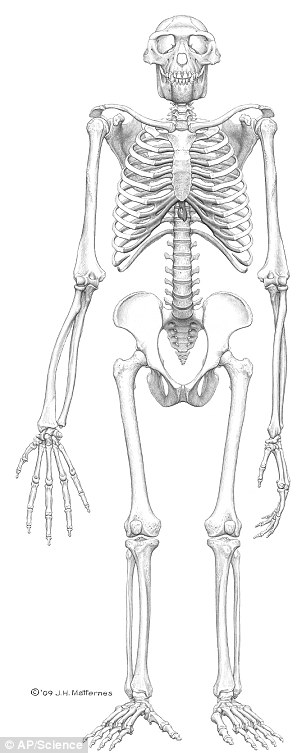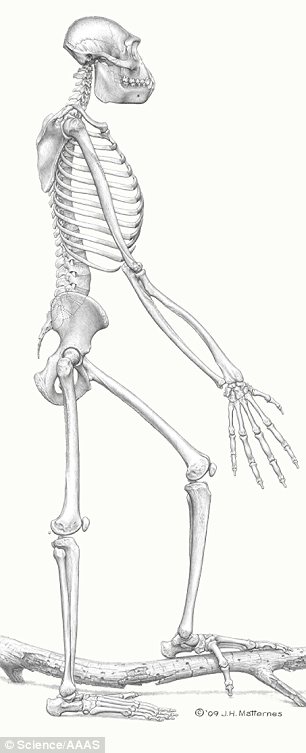Ab-Titchaz
JF-Expert Member
- Jan 30, 2008
- 14,631
- 4,225
Ardi: The Oldest Human Skeleton Discovered
Guest post by Jamie Shreeve, National Geographic Magazine Science Editor
The big news in the journal Science tomorrow is the discovery of the oldest human skeleton--a small-brained, 110-pound female of the species Ardipithecus ramidus, nicknamed "Ardi." She lived in what is now Ethiopia 4.4 million years ago, which makes her over a million years older than the famous "Lucy" fossil, found in the same region thirty-five years ago.
Buried among the slew of papers about the new find is one about the creature's sex life. It makes fascinating reading, especially if you like learning why human females don't know when they are ovulating, and men lack the clacker-sized testicles and bristly penises sported by chimpanzees.
One of the defining attributes of Lucy and all other hominids--members of our evolutionary lineage, including ourselves--is that they walk upright on two legs.
While Ardi also walked on two legs on the ground, the species also clambered about on four legs in the trees. Ardi thus offers a fascinating glimpse of an ape caught in the act of becoming human.
The problem is it is doing it in the wrong place at the wrong time--at least according to conventional wisdom, which says our kind first stood up on two legs when they moved out of the forest and onto open savanna grasslands. At the time Ardi lived, her environment was a woodland, much cooler and wetter than the desert there today.
So why did her species become bipedal while it was still living partly in the trees, especially since walking on two legs is a much less efficient way of getting about?
According to Owen Lovejoy of Kent State University, it all comes down to food, and sex.
In apes--both modern apes and, presumably, the ancient ancestors of Ardipithecus--males find mates the good old-fashioned apish way: by fighting with other males for access to fertile females. Success, measured in number of offspring, goes to macho males with big sharp canine teeth who try to mate with as many ovulating females as possible. Sex is best done quickly--hence those penis bristles, which accelerate ejaculation--with the advantage to the male with big testicles carrying a heavy load of sperm. Among females, the winners are those who flaunt their fertility with swollen genitals or some other prominent display of ovulation, so those big alpha dudes will take notice and give them a tumble, providing a baby with his big alpha genes.
Let's suppose that some lesser male, with poor little stubby canines, figures out that he can entice a fertile female into mating by bringing her some food. That sometimes happens among living chimpanzees, for instance when a female rewards a male for presenting her with a tasty gift of colobus monkey.
Among Ardipithecus's ancestors, such a strategy could catch on if searching for food required a lot of time and exposure to predators. Males would be far more successful food-providers if they had their hands free to carry home loads of fruits and tubers--which would favor walking on two legs. Females would come to prefer good, steady providers with smaller canines over the big fierce-toothed ones who left as soon as they spot another fertile female. The results, says Lovejoy, are visible in Ardipithecus, which had small canines even in males and walked upright.
Lovejoy's explanation for the origin of bipedality thus comes down to the monogamous pair bond. Far from being a recent evolutionary innovation, as many people assume, he believes the behavior goes back all the way to near the beginning of our lineage some six million years ago.
But there is one other, essential piece to this puzzle that leaves no trace in the fossil record. If the female knew when she was fertile, she could basically cheat the system by taking all the food offered by her milquetoast of a provider, then cuckold him with a dominant male when she was ovulating, scoring the best of both worlds. The food-for-sex contract thus depends on what Lovejoy calls "the most unique human character"--ovulation that not only goes unannounced to the males of the group, but is concealed even from the female herself.
Regular meals, monogamy, and discretion--who would have thought our origins were so sedate?
The big news in the journal Science tomorrow is the discovery of the oldest human skeleton--a small-brained, 110-pound female of the species Ardipithecus ramidus, nicknamed "Ardi." She lived in what is now Ethiopia 4.4 million years ago, which makes her over a million years older than the famous "Lucy" fossil, found in the same region thirty-five years ago.
Buried among the slew of papers about the new find is one about the creature's sex life. It makes fascinating reading, especially if you like learning why human females don't know when they are ovulating, and men lack the clacker-sized testicles and bristly penises sported by chimpanzees.
One of the defining attributes of Lucy and all other hominids--members of our evolutionary lineage, including ourselves--is that they walk upright on two legs.
While Ardi also walked on two legs on the ground, the species also clambered about on four legs in the trees. Ardi thus offers a fascinating glimpse of an ape caught in the act of becoming human.
The problem is it is doing it in the wrong place at the wrong time--at least according to conventional wisdom, which says our kind first stood up on two legs when they moved out of the forest and onto open savanna grasslands. At the time Ardi lived, her environment was a woodland, much cooler and wetter than the desert there today.
So why did her species become bipedal while it was still living partly in the trees, especially since walking on two legs is a much less efficient way of getting about?
According to Owen Lovejoy of Kent State University, it all comes down to food, and sex.
In apes--both modern apes and, presumably, the ancient ancestors of Ardipithecus--males find mates the good old-fashioned apish way: by fighting with other males for access to fertile females. Success, measured in number of offspring, goes to macho males with big sharp canine teeth who try to mate with as many ovulating females as possible. Sex is best done quickly--hence those penis bristles, which accelerate ejaculation--with the advantage to the male with big testicles carrying a heavy load of sperm. Among females, the winners are those who flaunt their fertility with swollen genitals or some other prominent display of ovulation, so those big alpha dudes will take notice and give them a tumble, providing a baby with his big alpha genes.
Let's suppose that some lesser male, with poor little stubby canines, figures out that he can entice a fertile female into mating by bringing her some food. That sometimes happens among living chimpanzees, for instance when a female rewards a male for presenting her with a tasty gift of colobus monkey.
Among Ardipithecus's ancestors, such a strategy could catch on if searching for food required a lot of time and exposure to predators. Males would be far more successful food-providers if they had their hands free to carry home loads of fruits and tubers--which would favor walking on two legs. Females would come to prefer good, steady providers with smaller canines over the big fierce-toothed ones who left as soon as they spot another fertile female. The results, says Lovejoy, are visible in Ardipithecus, which had small canines even in males and walked upright.
Lovejoy's explanation for the origin of bipedality thus comes down to the monogamous pair bond. Far from being a recent evolutionary innovation, as many people assume, he believes the behavior goes back all the way to near the beginning of our lineage some six million years ago.
But there is one other, essential piece to this puzzle that leaves no trace in the fossil record. If the female knew when she was fertile, she could basically cheat the system by taking all the food offered by her milquetoast of a provider, then cuckold him with a dominant male when she was ovulating, scoring the best of both worlds. The food-for-sex contract thus depends on what Lovejoy calls "the most unique human character"--ovulation that not only goes unannounced to the males of the group, but is concealed even from the female herself.
Regular meals, monogamy, and discretion--who would have thought our origins were so sedate?













